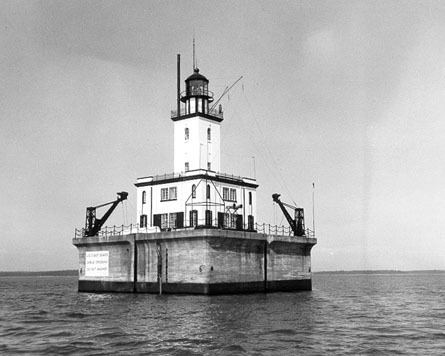Automated 1974 Opened 1930 Focal height 23 m Added to NRHP 15 March 2005 | Year first lit 1931 Area 404.7 m² | |
 | ||
Tower shape Square tower, Integral White square superstructuredecahedron lantern Markings / pattern White with black trim & red roof Constructions Reinforced concrete, Steel Similar Martin Reef Light Station, Poe Reef Light, Lake Huron, Pipe Island Light, Lansing Shoals Light Stati | ||
Detour reef lighthouse pure michigan minute
The DeTour Reef Light is a non-profit-operated lighthouse marking the southern entrance of the DeTour Passage between the eastern end of Michigan's Upper Peninsula and Drummond Island. The light is an automated active aid to navigation. It marks the northern end of Lake Huron. The passage is used by almost all of the Great Lakes commercial freighter traffic moving to and from Lake Superior, with approximately 5,000 vessel movements annually. It is said to be "the gateway to Lake Superior." In addition, many recreational boaters use the passage. The Light is located in Lake Huron, three miles (5 km) south of the nearest town, DeTour Village, Michigan.
Contents
- Detour reef lighthouse pure michigan minute
- Lighthouse history
- Lighthouse privatization
- Getting there
- Lighthouse relics
- References
Detour reef lighthouse pure michigan minute
Lighthouse history
The southern entrance to DeTour Passage is made dangerous by a shoal, DeTour Reef. In order to enter or leave the passage, boats must thread past a shallow area no more than 23 feet (7.0 m) deep.
In 1847 a lighthouse was located on shore at Point DeTour, Michigan to protect the DeTour Passage at the northwestern end of Lake Huron. In 1931 it was moved offshore on to DeTour Reef. It is locally called the "Gateway to Superior”.
The DeTour Reef Lighthouse, raised in 1931, not only marks the channel, but also is built atop DeTour Reef on a crib structure, and warns boats away from it. The lighthouse and its concrete base are 83 feet (25 m) tall.
After commercial bids were determined to be unsatisfactory, the light was constructed by the U.S. Army Corps of Engineers. The structure was finished in 327 working days. This iteration of the light was built for $140,000. Some sources have described it as "Art Deco."
The concrete foundation is similar to the Martin Reef Light located about 10 miles (16 km) to the west, and Poe Reef Light located near Cheboygan, Michigan. The same crew built all three lights around the same time. It is almost a 'fraternal twin' of the Fourteen Foot Shoal Light which was built in 1930. In that sense, by using the same crews, equipment and personnel, the builders followed in the tradition of the builders of Spectacle Reef Light, White Shoal Light, and Waugoshance Light, thereby achieving real savings and efficiency.
This light (and its predecessor) have gone through many different lenses in its 160-year history.
A concise explanation on the different lenses and their technology is available at Lighthouse Illumination Technology, Terry Pepper, Seeing the Light.
This is part of a larger pattern of building 14 reef lights around Michigan, which was intended to help ships navigate through and around the shoals and hazards.
The station was equipped with a F-2-T diaphone fog signal, which was preserved at the Great Lakes Historical Society in Ohio. It has been returned to the custody of the lighthouse complex.
Lighthouse privatization
In 1998, the National Trust for Historic Preservation named Michigan’s historic lighthouses, with DeTour Reef Light being their prime example to their 1998 List of America’s 11 Most Endangered Historic Places. This was the first time a lighthouse was included on the annual list. This gave impetus to the DeTour Reef Lighthouse Preservation Society, and lent them national recognition.
Like many U.S. lighthouses, in 1997 the DeTour Reef Lighthouse was "deemed excess" and no longer needed by its former owner, the United States Coast Guard. In response, in 1998, the DeTour Reef Light Preservation Society (DRLPS) was established as a nonprofit 501c3 volunteer organization to restore and preserve the DeTour Reef Light.
The Coast Guard transferred control and, finally, ownership over DeTour Reef Light to the DRLPS in a series of rolling steps. These steps tracked the a successful DRLPS $1.2 million fundraising effort and demonstration that they could take on ownership of the Light:
The DeTour Reef Lighthouse was added to the National Register of Historic Places in March 2005 under the title of the "DeTour Reef Light Station" as NRHP listing #05000151.
Detour Reef Light is one of more than 150 past and present major "lights" (which are greater in number than "lighthouses"—which implies a keeper's quarters)—in Michigan. This is just one of the 40 lighthouses in Michigan which have been transferred to private ownership in the recent past.
Getting there
As of 2009, "public tours of this unique historic offshore Michigan maritime monument are now being offered", for the first time in the 74-year history of the lighthouse.
It should be noted that the light is only accessible by boat. The DRLPS offers boat trips to, and tours of, the lighthouse. A significant fee is charged to help cover the operating costs of maintaining the lighthouse. Also offered to a relatively small number of contributors are a limited number of occupancy nights for guests to stay in the lightkeeper's quarters; the quarters are restored to their appearance in and around 1956 (its last year of full-time occupation before automation). Guests are expected to help show the Light, and to perform lightkeeping chores, as a condition of their occupancy.
Lighthouse relics
The DeTour Reef Light's former 3½-order Fresnel lens, taken out of service in 1978, is displayed at the DeTour Passage Historical Museum in DeTour, Mich. and the lighthouse's former diaphone foghorn has been returned to the custody of the DeTour Reef Light Preservation Society. It is temporarily displayed at the Drummond Island Historical Museum.
